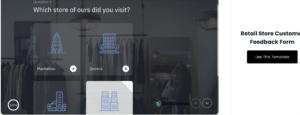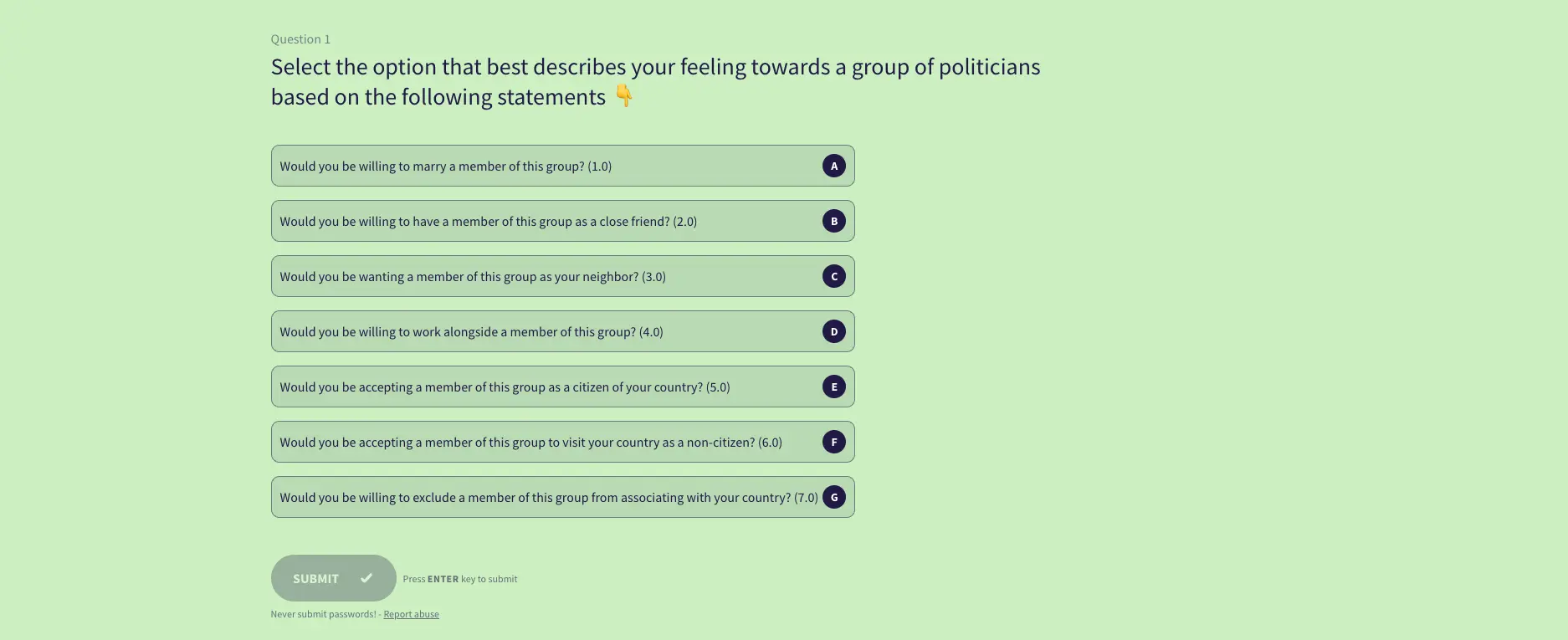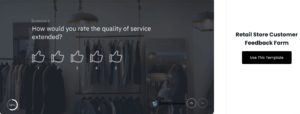Survey & Feedback
50+ Retail Survey Questions to Ask Your Customers for Feedback
Article written by Pragadeesh Natarajan
pragadeesh
12 min read
19 September 2025

60 Seconds Summary:
Retail surveys are an invaluable tools for gathering customer feedback and enhancing business strategies. By asking the right questions, retailers can gain insights into customer satisfaction, shopping habits, and areas for improvement. Key question types include:
- Net Promoter Score® (NPS): Measures customer loyalty.
- Customer Satisfaction Score (CSAT): Assesses overall satisfaction.
- Customer Effort Score (CES): Evaluates ease of interaction.
- Brick and Mortar Store Questions: Focus on customers’ experiences and satisfaction with physical retail locations.
- Open-Ended Questions: Gather detailed customer suggestions.
Incorporating these question types into your surveys can lead to actionable insights, improved customer experiences, and ultimately, business growth.
Two shoppers. Two very different experiences.
Shopper A walks into your store, already browsed your online store for a sneaker but wants to try them on. After finding the right size, they check out quickly, helped by a friendly cashier and leave happy.
Meanwhile, Shopper B also found something they liked online—a jacket—but the sizing was unclear and the product images weren’t detailed enough. Uncertain, they chose to buy from a competitor instead.
What made Shopper A’s experience better? Where did Shopper B’s journey fall short?
This is where retail surveys come into play.
Consider this: 51% of Americans prefer online shopping, yet a substantial 49% of consumers express dissatisfaction with not being able to try products when shopping online. Despite the convenience and wide range of choices online shopping offers, the inability to physically interact with products before purchase remains a significant drawback for many consumers.
Collecting and responding to customer feedback is crucial for online and offline retailers. By understanding consumer preferences and addressing the limitations of each shopping mode, retailers can improve customer satisfaction.
This article lists the best retail survey questions you can ask your customers to make quick improvements and address more comprehensive challenges.
Best Retail Survey Questions to Ask Your Customers
Here are the kinds of retail customer experience survey questions you can ask your customers:
- Net promoter score®
- Customer satisfaction score
- Customer effort score
- Binary yes/no survey
- Retail product and pricing questions
- Brick-and-mortar store questions
- Product selection and stock
- Service and returns for online and in-store experiences
- Demographic questions
- Product information on your website and in-store
- Open-ended follow-up questions
Ready to gather insightful feedback from your retail customers?
Elevate your strategy with SurveySparrow’s free Retail Survey Template —designed for comprehensive and customizable feedback collection. No credit card required to get started.
PS: This is a sample survey. Feel free to customize the questions and structure with our AI survey maker. Here, take a look.👇
Retail Store Customer Feedback Form
Use This TemplateFor the rest of us, let’s go explore retail survey questions and question types. Let's go!
1. Net Promoter Score® (NPS) Question
The Net Promoter Score® (NPS) survey is a customer loyalty metric that gauges overall customer satisfaction and loyalty to a brand or company. It is based on a single, straightforward question.
- How likely are you to recommend our store to your friends and family?
This question is typically answered on a scale of 0-10, with respondents categorized as Promoters (9-10), Passives (7-8), and Detractors (0-6). The NPS is calculated by subtracting the percentage of Detractors from the percentage of Promoters.
Pro tip: Follow up your NPS question with an open-ended “Why did you give this score?” to uncover specific improvement opportunities.
Use this free NPS calculator to quickly analyze your score
Explore best practices to improve your NPS and turn Detractors into Promoters
2. Customer Satisfaction Score (CSAT) Question
The Customer Satisfaction Score (CSAT) is a commonly used key performance indicator that gauges customer satisfaction with a product, service, or experience. The CSAT question typically asks the customer:
- How satisfied were you with your in-store experience?
Customers are then asked to rate their satisfaction on a scale, often ranging from very dissatisfied to very satisfied, or a numerical scale. Emoticons are also used to understand customer feedback.
Measurement tip: Use a 5-point scale from “Very Dissatisfied” to “Very Satisfied” or emoticons for higher engagement.
Learn what makes a good CSAT score and how to interpret it effectively
3. Customer Effort Score (CES) Question
The Customer Effort Score (CES) is a metric used to evaluate the ease of an experience or the effort required from a customer to get an issue resolved, a request fulfilled, or a product or service used. The CES question typically asks the customer to rate their agreement with a statement like:
- Did the company make it easy for me to handle my issue?
- How much effort did you personally have to put forth to handle your request?
- How easy was it to find what you were looking for?
The customer chooses the options or ratings.
Use this ready-to-go CES survey template to start measuring customer effort
4. Binary Yes/No Survey Question
A binary yes/no survey question is a straightforward form of inquiry used in various surveys, including customer feedback, market research, and social science studies.
- Did you find what you were looking for?
- Did you find our checkout process easy to use?
This type of question requires respondents to choose between two definitive options: ‘Yes’ or ‘No.’ It gathers clear, unambiguous data about people’s opinions, experiences, or behaviors.
Explore smart ways to use Yes/No survey questions for maximum insight

5. Retail Product and Pricing Questions
Retail product and pricing questions in surveys are designed to understand customers’ perceptions and satisfaction with the products and pricing of a retail business.
- How satisfied are you with the [product/service]?
- How fair are the prices compared to similar retailers?
- What could we do to improve the [product/service]?
- How satisfied are you with the value for money of your purchase?
6. Brick-and-Mortar Store Questions
Brick-and-mortar store questions in surveys typically focus on customers’ experiences and satisfaction with physical retail locations.
- The store hours are convenient for me.
- It was easy for me to find parking.
- How would you rate the cleanliness of the fitting rooms?
- How satisfied are you with the wait time in the fitting rooms?
- The [displays/mannequins] help me decide what to buy.
- How can we improve your experience with the fitting rooms?
- How satisfied are you with the wait time at checkout?

7. Product Selection and Stock
Product selection and stock in a retail context refers to the variety of products available for purchase and managing inventory levels to meet consumer demand.
- The [store/site] made it easy to find what I was looking for.
- Did you find what you were looking for today?
- Did we have what you were looking for in stock?
- How often do we have what you’re looking for in stock?
- How satisfied are you with the selection in [product category]?
- It was easy for me to find something in my size.
- What other products would you be interested in purchasing from us?
- Did we advertise something that we did not have in-store?

8. Service and Returns for Online and In-Store Experiences
These survey questions are designed to assess customers’ satisfaction and experiences with the service quality and the return process for online purchases and in-store shopping.
- How satisfied were you with the service overall?
- How knowledgeable was the staff?
- Did someone help you while you were shopping today?
- How friendly was the staff?
- How helpful was the staff?
- [Website/app/self-checkout] made it easy for me to purchase the product.
- How well did the staff understand your needs?
- Was your customer service issue resolved?
- How satisfied are you with the resolution of your customer service issue?
- Website/store] made it easy to make a return.
- How fair is the return policy?
- How satisfied are you with the return policy?
- Website/store/agent] made it easy for me to resolve my customer service issue.
- How satisfied are you with the warranty?
These questions aim to gather feedback on aspects like the ease of making returns, the helpfulness of customer service, and the overall efficiency and convenience of the service and return procedures in different shopping environments.
9. Demographic Questions
Demographic questions in surveys are used to gather specific information about the characteristics of the survey respondents. These characteristics typically include age, gender, income, education level, ethnicity, employment status, and geographic location.
- What is your age group?
- Select your gender.
- Please enter the city you live in.
- Please select your educational qualification.
- Are you into a business, profession, or job?
Demographic questions help segment and understand the diverse backgrounds of the respondents, allowing for a more nuanced analysis of survey results about different population segments.

10. Product Information on Your Website and In-Store
Product information on your website and in-store refers to the details provided about products both online and within physical retail locations. This includes descriptions, pricing, availability, and other relevant data.
- How satisfied are you with the product information provided?
- How satisfied are you with the product images provided?
- Are the product demos helpful?
- How can we improve your understanding of the product?
Consistency in this information across both platforms is essential for maintaining customer trust and ensuring a cohesive shopping experience.

11. Open-Ended Follow-Up Questions
Open-ended follow-up questions in surveys are inquiries that allow participants to freely express their thoughts and provide detailed feedback, offering deeper insights into their experiences and opinions.
- What was the reason for your visit today?
- How often do you visit the store?
- Did a coupon or promotion bring you into the store today?
- How did you hear about us?
- What other [brands/retailers] did you consider purchasing this product from?
- Is there anything else you’d like to tell us?
- Can we contact you to follow up in more detail on your responses?
These questions are crucial for gaining a more nuanced understanding of customer perspectives and motivations that can’t be captured through fixed response options.

Best Practices for Retail Surveys Practices
To maximize the value of your retail surveys, follow these proven strategies:
1. Keep surveys brief and focused
Respect your customers’ time by keeping retail survey questions concise:
Aim for 5-7 minutes completion time
Focus on one aspect of the experience per survey
Use skip logic to show only relevant questions

2. Right timing
Survey timing significantly impacts response quality:
In-store: Capture feedback immediately at checkout or via QR codes
Online: Send post-purchase surveys 1-3 days after delivery
Seasonal: Run comprehensive experience surveys quarterly
3. Give incentives for responses
Boost participation with strategic incentives:
Offer small discounts on future purchases
Enter respondents into prize drawings
Provide loyalty points for complete responses
4. Act on feedback and close the loop
The most crucial step is following up on what you learn:
Share insights with relevant teams
Implement changes based on feedback patterns
Communicate improvements back to customers
Final thoughts
The feedback from retail surveys helps you understand what your customers want, enhance your retail CX, and maintain a competitive advantage over your direct competitors.
Gathering feedback is the first step while the real work is when you analyze the trends across customer segments, identify priority improvements, implement those changes and measure the results while communicating it to the customers.
Are you looking to create and automate retail surveys by yourself? SurveySparrow provides you with everything you need to create and conduct conversational surveys!
Our surveys typically tend to boost survey responses and create pleasant experiences. Most of your customers will complete your survey as they would be pleased to take surveys that are conversational in nature.
SurveySparrow provides you with a simple drag-and-drop interface and free retail survey question templates.
Collect retail feedback effortlessly using kiosks, tablets, and smartphones - take SurveySparrow for a spin today!

Do you have any questions about retail surveys? Do you have any interesting best practices or tips for creating retail surveys? Let us know in the comment section below.
If you’re wondering whether SurveySparrow is the right fit for you and would rather have someone walk you through our platform, reach out to us for a free, personalized demo!

Create engaging surveys that people actually complete. Try SurveySparrow now!
Pragadeesh Natarajan
I'm a developer turned marketer, working as a Product Marketer at SurveySparrow — A survey tool that lets anyone create beautiful, conversational surveys people love to answer.
Frequently Asked Questions (FAQs)
Effective survey questions are clear, concise, and focused on obtaining actionable insights.
- How satisfied are you with your recent shopping experience?
- How easy was it to find our store or website?
- Did our staff assist you promptly and courteously?
- Was the product selection adequate for your needs?
- Would you recommend our store to others?
Ask about overall experience, staff helpfulness, ease of finding products, store cleanliness, and improvements.
Focus on why they visited, product availability, pricing, return intent, and suggestions.
Ask how happy they are with products, service, prices, layout, and overall experience.
Related Articles

Survey & Feedback
Why Data Security Teams Should Use Feedback Surveys to Assess Compliance Readiness
8 MINUTES
31 October 2025

Survey & Feedback
50+ Rating Scale Questions to Make Your Surveys Engaging
14 MINUTES
5 July 2022

Survey & Feedback
Bogardus Social Distance Scale: Definition, Survey Questions with Examples
11 MINUTES
28 April 2022

Survey & Feedback
How to Get Quicker and Easier Surveys with Autoadvance
5 MINUTES
20 September 2024





